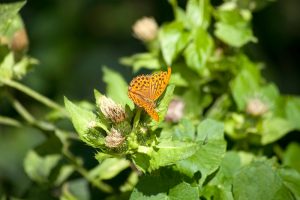Beneficial Bugs That Love Your Fall Leaves
Our ancestors who encountered the vast deciduous forests of eastern North America logically popularized the name “Fall” for the third season of the year. Four hundred years later, we have fewer and smaller trees around us and powerful mowers, blowers and mulchers at the ready to keep our yards neat and tidy. There is no shortage of ways to explore and interpret the changes that have taken place over the centuries. One of those ways relates to natural cycles.
What changes when we take away the fallen leaves?
No doubt, our predecessors removed the fallen leaves as they deemed necessary and then used them in thrifty and ingenious ways. After all, the newly deposited spent foliage insulates sensitive plant roots from temperature fluctuations, slows runoff of rainfall and snowmelt, and returns nutrients back to the soil to feed plants. The fallen leaf layer also provides a sheltering place for thousands of small creatures to survive the winter.
Bees
Bees are our most important pollinators. Unlike imported honeybees, 4,000 native North American bee species live in small colonies or as solitary individuals, mostly overwintering in dead leaves and plant stems. For example, bumble bee queens spend the winter at or just below the surface of the ground, waiting to start new colonies when spring arrives. Fallen leaves add an insulating layer for protection from weather and predators.
Beetles
The word “beetle” may invoke thoughts of nefarious pests like Japanese beetles. But for every pest there are hundreds of helpful species like soldier beetles that prey on pests, ground beetles that build soil and long-horned beetles that pollinate plants. Without their contributions our work in the yard or garden becomes infinitely more difficult. They need the protection, and in some cases food source, of fallen leaves to survive the winter.
Butterflies and moths
Although the migration of Monarch butterflies understandably captivates our attention, most butterflies and moths do not fly thousands of miles each spring and fall. Instead they spend their winters as eggs, caterpillars, or as pupae in cocoons or chrysalises hidden among fallen leaves and weeds. If you love Luna Moths, Wooly Bear caterpillars, Fritillaries, and Swallowtails, be sure and give them a secure place to stay.
Don’t leave the leaves…keep the leaves
In our search for ways to keep the yard neat and tidy while at the same time making room for nature, we sometimes encounter conflicts. Good bugs need leaf litter for their survival, but a thick leaf layer shades sun-loving lawn grass and eventually becomes matted, smothering the lawn. Is it possible to have both? In order to keep a great looking lawn and provide a place for overwintering insects, you have at least three options: mow and mulch, mow and bag, or blow (and shred).
Remove excess leaves
Continue mowing the grass until it stops growing, regardless of falling leaves. While leaf cover is not excessive, simply mulch them into the lawn. The material will break down and beneficial bugs at the grass root zone will appreciate added cover as the nights become cold. If leaf cover becomes excessive, it will be necessary to remove them for the health of the lawn. Attach a bagger to the mower to make the job easier.
When the grass has stopped growing for the season, mow, rake or blow the leaves off the lawn to avoid excessive buildup. If space permits, use the excess leaves to create winter habitat for good bugs in garden and landscape beds. Simply pile the intact leaves and allow them to break down naturally; or, shred them to a fine texture to reduce blowing.
Where to put fall leaves
Leaves are nature’s mulch. Use them in the same places that you would place store-bought mulch such as tree rings, ornamental landscape beds, and annual flower and vegetable garden beds. Not only will the leaves provide a home for overwintering insects, but your garden and landscape plants will get a boost from the natural composting process.
Spring clean up
By spring, the leaf piles will have shrunken to half the original size. Possibly even smaller. If possible, leave them where they lay until the landscape plants have fully awakened. By that time most of the insects will have emerged from their winter slumber as well. They will continue to reuse the debris as long as you leave it in place, eventually helping to convert last year’s leaves into a part of the soil.
But if the remnants of temporary winter leaf piles must be removed in spring, you can take pride in the fact that your yard was an essential overwintering hot spot for some of the best garden helpers.



You must be logged in to post a comment.